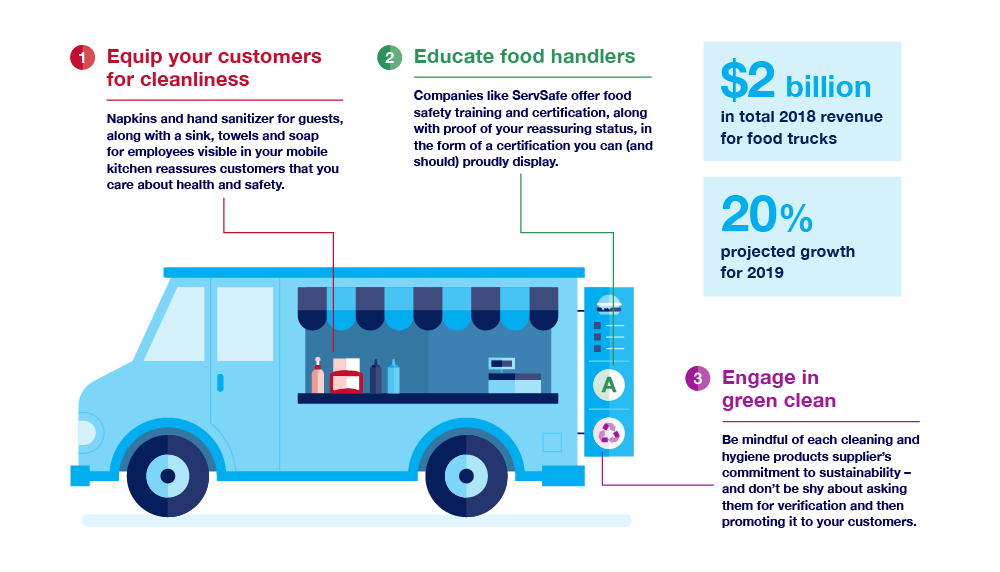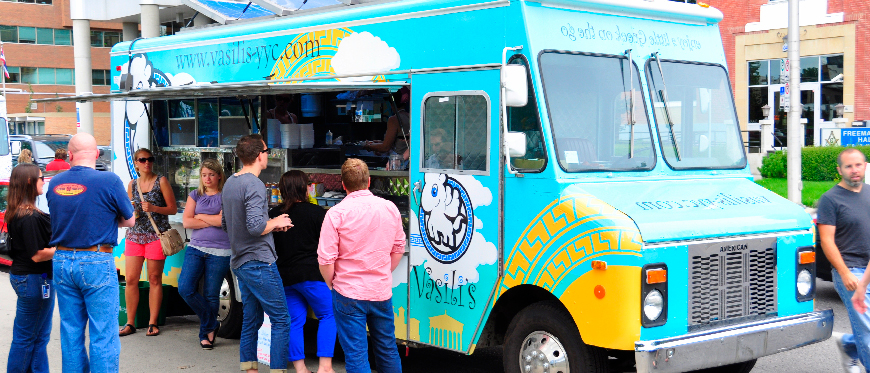There’s a crucial message missing in all the euphoria about the $2 billion in total 2018 revenue for food trucks, and the projected 20% growth for 2019: You could do even better.
That’s because, despite the continued trend toward eating on the go, “hygiene on the go” just isn’t keeping up – and that’s keeping customers away. Research shows that nearly half of all people worry about getting sick if they eat at a food truck, and 40% avoid street food altogether because of a lack of hygiene products. Fortunately, the flip side of this problem is a relatively simple solution: Up your game in food truck hygiene. You can start with the following four steps.

Download the complete infographic (PDF)
One: Equip your customers for cleanliness
A study of some 15,000 consumers showed that those food-truck-avoiding customers aren’t walking right on by because your avocado tacos or vegan BBQ ribs don’t look delicious – they’re staying away because they’re looking for signs of health and safety. These can be simple signs, like the presence of napkins, hand sanitizer or even just soap -soap for staff handwashing? Customers wouldn’t be offered soap out and visible in your mobile kitchen. So, have plenty of those supplies on hand, prominently displayed and within easy reach (and consider printing customized napkins to help customers spread the word that your food truck is trustworthy? Like custom napkins but that would be an unusual message for guests).
Two: Educate your food handlers
As concerned as customers are about their own cleanliness, they may be even more concerned with the hygienic habits of your staff. After all, they’ve seen the news reports about how food trucks are closed at a rate three times higher than restaurants, with food handlers frequently cited for failing to wash their hands, use gloves, or clean surfaces properly. Be sure that a handwashing station for staff is fully equipped with hygienic soap and paper towel dispensers.
Part of the solution for employees is to equip them with the supplies they need, such as cleaning products and disposable wipers (to avoid contamination from reused or seldom-washed cloth rags). But food truck workers also need education, both in terms of the specific challenges of working safely in a very small space and in the habits they must develop to keep themselves, their workspace and the food they offer safe Organizations such as ServSafe offer food safety training and certification, along with proof of your reassuring status, in the form of a certification you can (and should) proudly display.
Three: Engage in green clean
Today’s consumers are trying to keep the whole earth clean, too, and have been proven to reward businesses that do the same. As you buy your cleaning and hygiene products, be mindful of each supplier’s commitment to sustainability – and don’t be shy about asking them for verification and then promoting it to your customers. Could say something about reducing usage or showing that you care about the environment by using recycled napkins (especially natural colored to make it obvious) and napkin systems that deliver napkins one at a time.
Four: Remember that food truck hygiene is a moving target
While food trucks are judged by the same health and safety standards as brick-and-mortar restaurants, they face many unique challenges. Just how many flies will that constantly-open service window let in? And how many ways can mice, rats, birds or any number of hungry pests find to gain entrance to your kitchen-on-wheels? (The answer is many, and, by one health department report, included a case where “Mice had crawled into the truck through the engine manifold when it was not in service.”) Food truck owners and managers need to inspect their mobile kitchens daily, and frequently have the non-kitchen parts of the vehicle examined for damage that could allow environmental contamination or easy access by pests.
According to the research, food trucks are only reaching 60% of the available marketplace. That missing 40% belongs to the mobile restauranteurs who understand that hygiene is the first item customers should see on their menus.
Download the complete infographic (PDF)
Sources:
Tork PPT on Seasonal Summer People on the Go
Restaurant: 9 Tips for Opening a Food Truck
Food Quality & Safety: Food Truck Safety
L.A. Times: The Dark Side of Trendy Food Trucks
Foodee: 12 Impressive Facts on the Food Truck Industry
